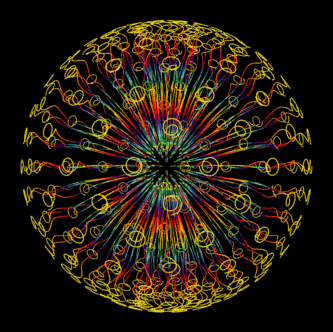

Excellent digital photo processing methods Dutchman Kees Venebosa was shown on National Geographic and NASA. Processing of images produced using Terragen landscape simulation. He worked with various versions of this program since 1999. Most of the photos were obtained by digital simulation of heights on NASA images from different satellites, such as the Mars Global Surveyor. He made a lot of pictures for National Geographic, not only Mars but also the old earth and other planets of the solar system and extrasolar planets in other systems. We've put together a collection of the most beautiful and fantastic photographs of Mars.
 1. the south end of the Holden crater. Rocky Mountains cover the sun breaks through the clouds, forming the shape of a star. Noačianskaâ was on Mars. It looks Mars some 4 billion years. The North crevice filled with water, the large lake at the bottom is the Meridiani. The Rover Opportunity found the presence of this inland sea. Images made for the July issue of National Geo ... for 2005. The southern part of Chryse Plain. Ancient form of South Chryse region, surrounded by valleys of Ares and Mariner.
Pouso robokara-Rover spirit. Gusev Crater fragment (in the background is Mount husband Hill). Ancient Mars, fumaroles, sediment from hot water.
Early morning on Mount Olympus. Sunrise in the morning fog on the plateau of Farsida. Mount Olympus is visible from the Lycus Sulci. Sailor Valley. Mostly the side of a mountain eroded valleys of Mariner. The Sk'âparelli crater. Low standing sun light hits the western edge. The diameter of Sk'âparelli crater is 450 kilometers (280 miles). Orcus Patera in the crater sunset. Orcus Patera The Crater unusual oval shape was formed by a meteorite, which lightly touched Mars. The southern edge of the Gale crater. Strange cloud above a ravine that leads to Gale crater. The cone of the crater can be seen just below the sun. Overlooking the northeast.
Pouso robokara-Rover spirit. It looks like a Guseva noačianskuû era. Other work is konce6ptual'naâ where there is more water and fumaroles. Mars today ... this was printed with noačianskoj image (bottom) in the July issue of National Geographic magazine for the year 2005.
The landing site of Phoenix. The right edge of Heimdall crater. Farsidy Mountain. Mountain Arsia, peacock and Ascraeus Mons. View southwest to the northeast. On the left is the Biblis crater (left) and the crater Odysseus.
1. the south end of the Holden crater. Rocky Mountains cover the sun breaks through the clouds, forming the shape of a star. Noačianskaâ was on Mars. It looks Mars some 4 billion years. The North crevice filled with water, the large lake at the bottom is the Meridiani. The Rover Opportunity found the presence of this inland sea. Images made for the July issue of National Geo ... for 2005. The southern part of Chryse Plain. Ancient form of South Chryse region, surrounded by valleys of Ares and Mariner.
Pouso robokara-Rover spirit. Gusev Crater fragment (in the background is Mount husband Hill). Ancient Mars, fumaroles, sediment from hot water.
Early morning on Mount Olympus. Sunrise in the morning fog on the plateau of Farsida. Mount Olympus is visible from the Lycus Sulci. Sailor Valley. Mostly the side of a mountain eroded valleys of Mariner. The Sk'âparelli crater. Low standing sun light hits the western edge. The diameter of Sk'âparelli crater is 450 kilometers (280 miles). Orcus Patera in the crater sunset. Orcus Patera The Crater unusual oval shape was formed by a meteorite, which lightly touched Mars. The southern edge of the Gale crater. Strange cloud above a ravine that leads to Gale crater. The cone of the crater can be seen just below the sun. Overlooking the northeast.
Pouso robokara-Rover spirit. It looks like a Guseva noačianskuû era. Other work is konce6ptual'naâ where there is more water and fumaroles. Mars today ... this was printed with noačianskoj image (bottom) in the July issue of National Geographic magazine for the year 2005.
The landing site of Phoenix. The right edge of Heimdall crater. Farsidy Mountain. Mountain Arsia, peacock and Ascraeus Mons. View southwest to the northeast. On the left is the Biblis crater (left) and the crater Odysseus.













Mars view